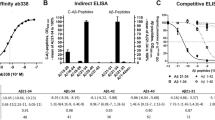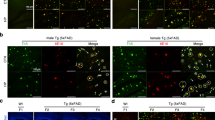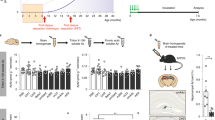Abstract
The only definitive diagnosis for Alzheimer disease (AD) at present is postmortem observation of neuritic plaques and neurofibrillary tangles in brain sections. Radiolabeled amyloid-β peptide (Aβ), which has been shown to label neuritic plaques in vitro, therefore could provide a diagnostic tool if it also labels neuritic plaques in vivo following intravenous injection. In this study, we show that the permeability of Aβ at the blood–brain barrier can be increased by at least twofold through covalent modification with the naturally occurring polyamine, putrescine. We also show that, following intravenous injection, radiolabeled, putrescine-modified Aβ labels amyloid deposits in vivo in a transgenic mouse model of AD, as well as in vitro in human AD brain sections. This technology, when applied to humans, may be used to detect plaques in vivo, allowing early diagnosis of the disease and therapeutic intervention before cognitive decline occurs.
This is a preview of subscription content, access via your institution
Access options
Subscribe to this journal
Receive 12 print issues and online access
$209.00 per year
only $17.42 per issue
Buy this article
- Purchase on Springer Link
- Instant access to full article PDF
Prices may be subject to local taxes which are calculated during checkout





Similar content being viewed by others
References
Maggio, J.E. & Mantyh, P.W. Brain amyloid—a physicochemical perspective. Brain Pathol. 6, 147–162 (1996).
Manelli, A.M. & Puttfarcken, P.S. Beta-amyloid-induced toxicity in rat hippocampal cells: in vitro evidence for the involvement of free radicals. Brain Res. Bull. 38, 569–576 (1995).
Weldon, D.T. et al. Fibrillar beta-amyloid induces microglial phagocytosis, expression of inducible nitric oxide synthase, and loss of a select population of neurons in the rat CNS in vivo. J. Neurosci. 18, 2161–2173 (1998).
Selkoe, D.J. Alzheimer's disease: genotypes, phenotype, and treatments. Science 275, 630–631 (1997).
Hsiao, K. et al. Correlative memory deficits, A-beta elevation, and amyloid plaques in transgenic mice. Science 274, 99–102 (1996).
Holcomb, L. et al. Accelerated Alzheimer-type phenotype in transgenic mice carrying both mutant amyloid precursor protein and presenilin 1 transgenes. Nat. Med. 4, 97–100 (1998).
Cummings, B.J. & Cotman, C.W. Image analysis of beta-amyloid load in Alzheimer's disease and relation to dementia severity. Lancet 346, 1524–1528 (1995).
Maggio, J.E. et al. Reversible in vitro growth of Alzheimer disease beta-amyloid plaques by deposition of labeled amyloid peptide. Proc. Natl. Acad. Sci. USA 89, 5462–5466 (1992).
Ghilardi, J.R. et al. Intra-arterial infusion of [I-125]A-beta 1-40 labels amyloid deposits in the aged primate brain in vivo. NeuroReport 7, 2607–2611 (1996).
Poduslo, J.F. & Curran, G.L. Increased permeability across the blood–nerve barrier of albumin glycated in vitro and in vivo from patients with diabetic polyneuropathy. Proc. Natl. Acad. Sci.USA 89, 2218–2222 (1992).
Poduslo, J.F. & Curran, G.L. Glycation increases in permeability of proteins across the blood–nerve and blood–brain barriers. Molec. Brain Res. 23, 157–162 (1994).
Poduslo, J.F., Curran, G.L. & Berg, C.T. Macromolecular permeability across the blood–nerve and blood–brain barriers. Proc. Natl. Acad. Sci.USA 9, 5705–5709 (1994).
Poduslo, J.F. & Curran, G.L. Polyamine modification increases the permeability of proteins at the blood–nerve and blood–brain barriers. J. Neurochem. 66, 1599–1609 (1996).
Poduslo, J.F. & Curran, G.L. Increased permeability of superoxide dismutase at the blood–nerve and blood–brain barriers with retained enzymatic activity after covalent modification with the naturally occurring polyamine, putrescine. J. Neurochem. 67, 734–741 (1996).
Wengenack, T.M., Curran, G.L., Olson, E.E. & Poduslo, J.F. Putrescine-modified catalase with preserved enzymatic activity exhibits increased permeability at the blood–nerve and blood–brain barriers. Brain Res. 767, 128–135 (1997).
Poduslo, J.F., Curran, G.L. & Gill, J.S. Putrescine-modified NGF: bioactivity, pharmacokinetics, blood–brain/nerve barrier permeability, and nervous system biodistribution. J. Neurochem. 71, 1651–1660 (1998).
Poduslo, J.F., Curran, G.L., Haggard, J.J., Biere, A.L. & Selkoe, D.J. Permeability and residual plasma volume of human, Dutch variant, and rat amyloid β-protein 1-40 at the blood–brain barrier. Neurobiol. Dis. 4, 27–34 (1997).
Poduslo, J.F., Curran, G.L., Sanyal, B. & Selkoe, D.J. Receptor-mediated transport of human amyloid beta-protein 1-40 and 1-42 at the blood–brain barrier. Neurobiol Dis. 6, 190–199 (1999).
Walker, L.C., Masters, C., Beyreuther, K. & Price, D.L. Amyloid in the brains of aged squirrel monkeys. Acta Neuropathol. 80, 381–387 (1990).
Vinters, H.V. & Pardridge, W.M. The blood–brain barrier in Alzheimer's disease. Can. J. Neurol. Sci. 13, 446–448 (1986).
Soto, C., Kindy, M.S., Baumann, M. & Frangione, B. Inhibition of Alzheimer's amyloidosis by peptides that prevent beta-sheet conformation. Biochem. Biophys. Res. Commun. 226, 672–680 (1996).
Poduslo, J.F., Curran, G.L., Kumar, A., Frangione, B. & Soto, C. Beta-sheet breaker peptide inhibitor of Alzheimer's amyloidogenesis with increased blood–brain barrier permeability and resistance to proteolytic degradation in plasma. J. Neurobiol. 39, 371–382 (1999).
Abbott, N.J., Chugani, D.C., Zaharchuk, G., Rosen, B.R. & Lo, E.H. Delivery of imaging agents into brain. Advances Drug Delivery Rev. 37, 253–277 (1999).
Acknowledgements
The authors wish to thank Dr. Shirley Poduslo for her generous gift of human AD brain tissue, Dr. Karen Duff for her generous gift of PS1 transgenic mice, and Dr. John Maggio for his valuable technical advice. The authors also wish to thank Shelly Whelan for her expert technical assistance and Jennifer Scott for her expert secretarial assistance.
Author information
Authors and Affiliations
Corresponding author
Rights and permissions
About this article
Cite this article
Wengenack, T., Curran, G. & Poduslo, J. Targeting Alzheimer amyloid plaques in vivo. Nat Biotechnol 18, 868–872 (2000). https://doi.org/10.1038/78482
Received:
Accepted:
Issue Date:
DOI: https://doi.org/10.1038/78482
This article is cited by
-
Temporal and anatomical distribution of 18F-flutemetamol uptake in canine brain using positron emission tomography
BMC Veterinary Research (2020)
-
Synthesis of amino-group functionalized superparamagnetic iron oxide nanoparticles and applications as biomedical labeling probes
Journal of Nanoparticle Research (2011)
-
Acceleration and inhibition of amyloid-β fibril formation by peptide-conjugated fluorescent-maghemite nanoparticles
Journal of Nanoparticle Research (2011)
-
MR Microimaging of amyloid plaques in Alzheimer’s disease transgenic mice
European Journal of Nuclear Medicine and Molecular Imaging (2008)
-
Kinetic Modeling of Amyloid Binding in Humans using PET Imaging and Pittsburgh Compound-B
Journal of Cerebral Blood Flow & Metabolism (2005)



